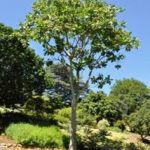TREE LIFE
October 2018
MASHONALAND CALENDAR
Saturday October 6th: Botanic Garden walk. Meet in the car park at 0830 hours. This is a great time in garden as there are so many trees flowering. The walk will last about an hour and a half.
Sunday October 21st: It is hot and dry and a lot of the trees are leafless SO have decided to go to Raintree Park in Umwinsidale, where is it cooler with the running water and shade. We will meet there at 0945 hours. Bring you chairs, cooler bag, lunch box, hat and in enjoy a day at this beautiful site.
Saturday October 27th: We are going to re-visit Greenwood Park, Herbert Chitepo/Josiah Chinamano/7th Street. This is an historic venue, first planted by the City Fathers to be the Botanic Garden of Salisbury in the 1920’s. Those of us who were on the last visit to this park will remember the very fine specimens of a large variety of trees there. Meet at the Josiah Chinamano (opposite the Police HQ) entrance at 1430 hours.
HARARE GARDENS WALK – 25 AUGUST 2018
Twelve of us enjoyed a pleasant afternoon’s botanising at the Harare Gardens. Present were: Meg; Mark; Jan; Bilal; Peter and Barbra Dean; Dawn, her daughter and family, Chantelle; Oliver and myself.
The first tree we looked at was the large Casuarina sp., Beefwood where we were waiting for everyone to arrive. We couldn’t identify the species as what appears to be leaves which look like pine needles are actually stems and the leaves at the nodes are minute and need a lens to be seen. Nearby was another Australian tree, Brachychiton populneus, Poplar-leafed Brachychiton in flower and has leaves resembling the Camphor tree.
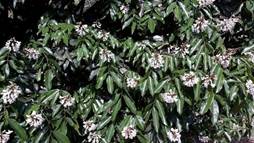
Crabia brevicaudata : Photo: Wikipedia
At the entrance we went through was a Craibia brevicaudata, Mountain Craibia with mature pods. Strangely enough, later on, we came across another Craibia near the restaurant that was about to flower – buds everywhere. We then went to the back of the Art Gallery and had a look at the Quercus suber, Cork oak. This oak is the source of commercial cork – harvesting the cork which can be up to 30cm thick stimulates the tree to produce more cork. Whilst in that area we looked at an Erythrina abyssinica, Red-hot-poker coral-tree and what may have been two Erythrina lysistemon, Sacred coral-tree. The smaller of the two had flowers which were sort of pink and the colouration of the bark was rather strange. We then came across several Syzygium jambos, Rose-apple in flower as well as a Callistemon viminalis, Bottle brush which we had a good look at – the features and smell of the leaves certainly resemble the Eucalypts. Next to be seen were two different types of what looked like Podocarpus trees – both unknown to us but Meg said the one had too many buds to be a yellow-wood, so what can it be?
Bilal identified what he called an Atlantic Blue Cedar that looked a bit like an Araucaria with prickly leaves. There were many palm trees, mainly Queen Palms and Washingtonias with a few Phoenix reclinata, Wild date palms. There also were quite a few Ficus lutea, Large-leaved fig but very few indigenous trees but we did see: Schotia brachypetala, Weeping boerbean; Senegalia polyacantha, White-stem thorn; Ficus burkei, Common wild fig; Ficus ingens, Red-leaved fig; Pseudolachnostylis maprouneifolia, Duikerberry; Croton sylvaticus, Forest croton; Trichilia dregeana, Natal forest mahogany; Polyscias fulva, Parasol-tree.
We came across a widespread, not too tall, flowerless Kapok tree with some of the lower big branches running along the ground. Meg commented that these branches will most likely take root and one day become trees. Other exotics seen were: a few Tabebuias, some full of yellow flowers; Acrocarpus fraxinifolius, Kenya coffee shade; Castanospermum australe, Morten bay chestnut; Citharexylum spinosum, Lady chancellor; Variegated Ficus elastic, Rubber tree; Melaleuca sp., Tea tree; Sapindus saponaria, Western soap-berry; Ginkgo biloba, Maidenhair tree and Magnolia champaca, Champak tree.
We had a look at the Victoria Falls replica which was no longer functioning, a pump used to circulate a lot of water upstream of the falls. The water cascaded over the falls, like the real thing, then went down several gorges only to be pumped back up again. There also were pipes producing heavy mist all along the falls and there was the road bridge linking us to Zambia! This area has many palm trees and one huge large-leaved fig and a few other trees – a Plane tree was spotted around here.
On the way back to the vehicles we came across what appeared to be two small fig trees growing and linked together high up on a World War 1 memorial.
-Tony Alegria
OUTING TO THETFORD GAME RESERVE 16 SEPT 2018
Our monthly Sunday tree walk had attracted a good crowd, gauging from the cars that had already passed the impressive gate at the entrance to the place. It had taken us 40min from Harare to get there.
Thetford Game Reserve situated in Christon Bank in the Mazowe valley was for most of us new land to be explored, while the tree Society had been there some years past. The place boasts of a considerable variety of birds and mammals. They claim to have about 900 individual animals inclusive of white rhino.
Colin, a local guide was waiting for us to then direct us to a place about 10 min driving inside the reserve. In a convoy of 7 cars we drove over well maintained gravel roads through dry miombo woodland. At one point a group of 6 giraffes interrupted their browsing to watch us passing and do some marketing for the place.
We parked on a large flat granite overlooking the Mazowe valley. Here Colin showed us the improvised toilet and left us to do our botanizing. As our main gurus were not available, we were lucky to have Tony to share his fast expanding knowledge and to lead the way. Still early spring with most trees just waking up, the most salient feature was the light green canopies from what proved to be Syzygium guineense, Water pear. Later on we also saw Syzygium cordatum, Water berry, close to the river. In an area not more than 1 acre we recorded an impressive list of trees.
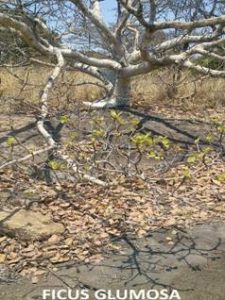
Photo : Jan van Bel
A big Monotes glaber, Pale-fruited I with a trunk of about 40 cm diameter (we were shown the leaf with its gland at the base of the blade) had a younger Ochna schweinfurthiana, brick-red ochna, and Combretum molle, velvet-leaved combretum, under its wings. A few meters further a tree with only a handful of leaves between the dry branches, had a smooth bark, but no spines. It was identified as Strychnos spinosa, Spiny monkey orange. The leaves were not yet fully developed, making identification more suggestive. Another tree nearby also had a smooth bark of cream color and had no leaves. The few seed pods still hanging were enough to name it Sterculia quinqueloba, large-leaved sterculia. Some huge dry leaves on the ground agreed with it. We saw another 2 or 3 of this species.
Besides the overwhelming presence of Syzygium, the place was further dominated by Julbernardia globiflora, Munondo; Brachystegia glaucescens,(tamarindoides) or Mountain-Acacia and the always impressive Brachystegia boehmii, Mufuti, although in smaller numbers. Also Lannea discolor, Live-long, came to the foreground. We saw 3 species of such size and age that it called for a review of our presumptive image of it.
Stepping out of the grassland and back on the granite, we were contemplating another cream colored smooth bark tree not more than 4 m high with heavy spreading boughs. It had just come in leaf. The leaves as well as stipules and petiole were visibly hairy. This was the only Ficus glumosa, African rock-fig, we encountered. We saw Terminalia sericea, Silver terminalia. Several Ficus sur, Broom-cluster fig, were counted that did not have the broom clusters, nor remnants of the previous year. Some old Gymnosporia senegalensis, Confetti tree, still had some leaves and could be identified. Searsia longipes, Large-leaved searsia, with fresh, healthy green color, standing out in this struggling dry landscape.
Then Tony spotted a small shrub or tree with a profusion of white-yellow grape-like bunches but no leaves. It was only about 1m high and he named it Cissus cornifolia . Under an old Pseudolachnostylis maprouneifolia, Duiker-berry, 3 young trees had found a healthy and shady footing: Euclea divinorum, diamond-leaved Euclea or magic guarri; Gymnosporia senegalensis and Mystroxylon aethiopicum, Kooboo-berry, with very thick leathery leaves with the edges regularly and clearly serrated.
A Senna singueana, Winter cassia, with one branch of the tree hesitantly starting to flower. In Harare most of the Senna’s are now past flowering stage. A Searsia leptodictya, Mountain karee, was growing only 10 m from a Searsia lancea, Willow Rhus or Karee. The first one had more erect and fresh leaflets. The second one was clearly more willowy and dryer while it was standing with one foot in the small river. Before we got to that brook, we saw a few Terminalia stenostachya, Rosette-leaved terminalia with dark furrowed barks and only a handful of dry leaves displayed. We recorded Vitex payos, Chocolate-berry, and Vangueria infausta, Wild-medlar.
Arriving at the brook we found Bridelia cathartica, Knobby bridelia, by looking at the knobby twigs. Coptosperma neurophyllum, Common tarenna, was looking livelier and greener than most trees around. Also with regular intervals we came across Parinari curatellifolia, Mobola plum. We saw only one Burkea africana, Red syringa, but always a happy sighting. Faurea saligna, Beechwood prompted us to look at the inter marginal vein on its leaves. A poor Flacourtia indica, Governor’s-plum, not at all impressive when you have the ones of hippo pools in mind. Remarkable was a Pavetta schumanniana, poison-bride’s bush, of an estimable age and with its trunk having a diameter of about 5 cm, unusually large for this tree that we regularly encounter.

Members enjoying a day at Thetford Game Reserve. Photo : Jan van Bel
Retreating to the cars, some people were attracted by the fresh green color of another large tree, a distance away. It had the color of the syzygiums but proved to be Cassia abbreviata, Shambok pod. It had only one threadbare shambok hanging. We then saw some more of these trees further away from the river, which had no leaves at all, but with more pods hanging. One had a few yellow buds just starting to open. Continuing over the granite slope where more trees had found a footing we also saw Hymenodictyon floribundum, firebush, without leaves but with plenty of dry fruit spikes to give it a label. Azanza garckeana, Snot apple, was only 2m high, but of a respectable age. A scrawny Ximenia caffra, Large sour plum, more or less like we are used to see them.
It was now time to look for a shady spot and have our picnic. We all wanted to see the dam and decided to drive there in the hope to find a shady spot. On our way there, driving between the miombo commons, we saw 2 Dombeya rotundifolia, Common wild-pear, in the distance. We stopped to look at a tree with fruits nearly as big as crabapples: Diospyros kirkii, River Dombeya. From the car we further spotted Catunaregam spinosa, Thicket-thorn catunaregam; Acacia (senegalia) polyacantha, White-stem thorn; Acacia (vachellia) karroo, Sweet thorn and Peltophorum africanum, African or Weeping wattle.
Arriving at the dam, we parked under some shady Brachystegia spiciformis, Msasa, which were elusive during our walk. At the border of the lake we also saw Peltophorum africanum, African-wattle; Pittosporum viridiflorum; a Ficus burkei and a few small Steganotaenia araliacea, Carrot-tree. A Searsia longipes, Large-leaved searsia, had an abundance of white berries and a Turraea nilotica, small mahogany, with no leaves also had plenty of fruit just developing .
We were satisfied with what we had seen and started our 40min drive back home.
-Jan van Bel
NATIONAL BOTANICAL GARDENS WALK – SATURDAY 1ST SEPTEMBER 2018
Present were: Mark; Meg; Chris & Beth Paver; Jim & Ann Sinclair; Bilal; Jan and myself.
The mission for the day was to look at trees in flower but we did look at the first tree that Tom Muller had planted – the Milicia excelsa, Mvule. Recently we were told that Tom always tried to plant a minimum number of any species of tree in threes, so now we know where the other two Milicias are! However, trees are not always in threes so presumably many haven’t made it to this point in time.
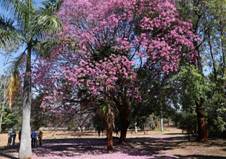
Tabebuia heterophylla Photo by Mark Hyde.
The first tree we looked at was just coming into flower, there were a few spikes on a Senegalia nigrescens, Knobthorn. Then we looked at our first Kigelia africana, Sausage-tree which had a few flowers open. I have never seen so many buds on these trees before, absolutely amazing and so it was with every other sausage tree we saw – they will soon be spectacular! Next we looked at an Albizia anthelmintica, Worm-cure albizia which was flowering profusely. What we see are the many stamens – I don’t think any petals can be seen on albizias. Next we looked briefly at a Combretum mossambicense, Shaving-brush combretum and then proceeded to a tree that looked like a Bombax which had many large white flowers – the petals had wilted away but the stamens were very showy. This tree was later identified by Mark as Pseudobombax ellipiticum, Shaving brush tree.
We then proceeded to a large pink tree which could be seen from far away. This is the pink Tabebuia heterophylla, Pink-trumpet tree and strangely enough all the branches were in full flower but leafless except for one branch which only had leaves!
We then proceeded to the other side of the Herbarium to look at a few more trees in flower, seen were: Combretum paniculatum, Forest burning-bush combretum, Bombax ceiba, Cotton tree and Fernandoa abbreviata with a Fernandoa magnifica label on it. During the labelling exercise we have noticed some trees that have been mislabelled by whoever put up the black and the cream labels.
We had a brief look at a couple of Podocarpus, yellowwoods and Albizia schimperianas, Forest long-pod albizias before calling it a day.
I look forward to seeing the Sausage trees on the October tree walk!
-Tony Alegria
The article below was on Facebook, put on by one of our members. I think a lot of our readers are avid “mopane” fans and will enjoy the facts and figures that Mr. O’Neill has shared with us. Mr. O’Neill is obviously a conservationist and lover of the Matabeleland Lowveld and all that goes with it. I hope you will enjoy it as much as I have. MCL
THE MICRO-ECOSYSTEM OF THE MOPANE TREE (Colophospermum mopane)
Personal, ongoing observations on Mhapaneni Ranch (Ndebele for ‘Lots of Mopane’) (formerly Taylors Block) in the Kezi District of Matabeleland South, Zimbabwe – C.B. O’Neill (June 2016)
Background
As on Mhapaneni Ranch, the majority of the surrounding area consists of predominantly Mopane stretching from the base of the Matobo Hills to over a 100 Km past Maphisa, West of Kezi to Gwanda and East of Kezi to Plumtree is all Mopane country.
Mhapaneni ranch has mostly sodic soils with predominantly Mopane woodland. There are also small pockets of ‘Gusu sands’ with predominantly Combretum, Terminalia and Dichrostachys tree species. There are numerous kopjes on the property and the biggest river forms the north and eastern boundary of the ranch. Through the middle runs the Simukwe River from which the majority of the ranch water was extracted in years gone by, through the sand. There are 7 stock dams on the property but when we arrived there was only 1 borehole. Interestingly enough there are no vleis on the ranch.
Wide-scale deforestation has occurred with indiscriminate cutting down of trees not sparing the Mopane trees. Thankfully some areas remained basically un-touched giving some very nice comparisons in between. Large areas of bare sodic soils with literally only Mopane trees and nothing else, (not even grass), make up a very large percentage of the ranch and this has a huge negative impact on the amount of grass actually growing on the ranch. These soils are very badly capped and showing increasing signs of chronic erosion as footpaths and trailing resulting from conventional grazing methods are now turning into gulleys wherever one looks.
The rainfall, though late, was fairly evenly spread throughout the whole area with an average season (540 mm), being recorded. The majority of the rain fell in February and March.
Present Management
The paddocks available total about 7,000Ha with roughly 3,000Ha being initially unusable as it was totally overgrazed. Stocking the ranch with cattle started on 1 January, 2015 and the numbers were gradually increased to 3,300 by November, 2015. The cattle on the ranch are now managed in an ‘ultra-high density grazing’ manner along the lines pioneered by Johann Zietsman and based on Allan Savory’s Holistic Management. In essence, it is herding with the help of portable electric fences. High animal impact and short duration grazing is used in an endeavour to not only get the animals adapted to their new conditions, but also address environmental degradation.
Observations
I have noticed many things about the Mopane tree and its role in the veld and aim, in no specific order of importance, record them so as to not forget my observations and to continue learning.
The Mopane Worms themselves:
Mhapaneni was the ONLY ranch this year that had significant mopane worm numbers this year… there were 2 flushes, as is common. The first flush in January was fairly small but the abundance of the mopane worms in March was amazing.
People, young and old alike, flocked onto the ranch from as far afield as Gwanda and Bulawayo, and at times, groups of people camped on the ranch to collect this “Manna from Heaven”. Many made long journeys everyday from the surrounding areas and I estimate that over this period of time which was basically about weeks there were often well over 150 people a day on the ranch collecting the delicacies.

Mopane Worm (Gonimbrasia belina). Male moth. Photo: C.B. O’Neill

Mopane Worm (Gonimbrasia belina). Female moth. Photo: C.B. O’Neill

Mopane Worm (Gonimbrasia belina) Mature Worm. Photo: C.B. O’Neil
It would be interesting to try to quantify the amount of protein harvested and a simple exercise would be to calculate that each person on average was harvesting an estimated 90 percent full 20l bucket of the gutted or stripped worms. An estimate of the weight in an average bucket collected this year would be about 10kg so if we say 150 were collecting that means they collected 1,500kg of stripped mopane worm each – this again to estimate will probably decrease by boiling to a third of that so 500Kg of dried mopane worms.
I have personally been offered dried or preserved mopane worms for sale packed into small packets with what I would estimate was about 10 -15 worms for 1 us $ a packet
When comparing this to Kapenta which sells for $4.00 /kg, it is really a significant number considering the second harvest lasted over 2 weeks.. The standard procedure is to collect the worms before stripping the stomach content by hand and washing the worm before boiling them in salt after which they can be kept for over a year as a very important traditional protein food.
Mopane Worm Droppings:
Mopane worm droppings have lain thick below many of the trees in granular form. This dung is in reality pure nitrogen, having been converted very efficiently by the worm from the green mopane leaf to be easily absorbed by the soil and ready to use by plants.
Though clearly visible, the majority of people are oblivious of the significance of this phenomenon, probably because artificial fertilizers have become a paradigm for us in this country.
An effective visual analogy would be to equate Mopane worm dung with granules of ammonium nitrate fertilizer, commonly known as “TOP” by local crop farmers. The second fertilizer commonly used by crop farmers is Compound D. (Nature’s source of “D” is anthill – evidenced by small-scale farmers planting their maize on anthills where they get the best results. The mortar from the termite tunnels stretching up the stems of the trees and, in many cases, snake right up in excess of 6 m high into the top most branches. This mortar eventually dries out and drops off around the base of the tree – yet another requirement for good grass growth being provided by nature, free of charge.
This year Nature has provided many examples of the “Mopane Magic” with hundreds of trees having very significant amounts of Mopane worm droppings at their base. To this has been added the soil made by termites as they exfoliate the bark of the living trees building – the anthill or compound “D” if you like.
Furthermore, other ants have started to work the Mopane worm pellets into the ground and their burrows, together with the termite burrows going up the trees, are leaving very efficient holes for aeration and any moisture to be absorbed and stored.
Grazing Management
In my opinion what is happening as a result of UHDG (ultra high density grazing) working “WITH NATURE” as opposed to against it and by treating the soil through:
Hoof action – loosening and aerating of the soil by breaking the capping
Herd effect – dunging and urination
We have, in the space of 1 season, been able to get the Mopane worms back in significant numbers by ”softening” the soil and retaining enough moisture in the soil to allow the determined Mopane worms to hide and bury themselves before they will later emerge as a moth for the cycle to continue.
The termites, like builders, can do nothing with cement but no water – UHDG improves water saturation in the plant allowing them to build their self protecting soil tunnels as they set about exfoliating trees of dead and dry bark before their armour to falls off to fertilize the soil.
G rass needs “TOP” and compound D to grow so the seed bed produced by the dung, urine, soft aerated ground is ready to grow as soon as any rain falls = better and better grass = healthier and healthier environment = better everything.
Apparently, as a general rule of thumb, the leaves of trees common here have an approx. 12 % protein value. However, this browse is not always available to cattle because of the tannin levels (tannin is a “coating” that prevents the uptake of the protein by the animal into the blood stream). Thankfully there is a product called Browse-plus, a tannin inhibitor which allows the ruminants to take in more leaves. We should be managing our cattle to eat more green leaves to convert into a higher quality dung with increased nitrogen for our seed beds. Unlocking more of the natural protein by breaking down the tannin with browse plus, now also means that we significantly increase the amount of feed available to our cattle, maybe even doubling it. This has huge potential especially when we are looking at reclaiming communal lands and we almost definitely will be starting with very little bulk in the form of grass.
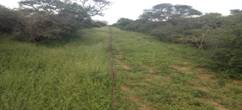
Good management = good grass cover. Photo: C. B. O’Neill
Another observation is that, not only are we getting grass growing back on areas that last year were bare Mopane “Chikwakwas” but the leaves on the mopane trees are still green. Control or comparative areas have much dryer leaves and some have already started falling off. We have a lot more Mopane’s that seeded this year compared to those in control areas. Having not seen enough to determine the role the seeds play, if any, in animal nutrition. Those seeds that have fallen, have not yet been eaten.
Every day I am amazed by the resilience of nature and how quickly this Matabeleland South area responds to management that works with nature – it would seem that it responds far quicker than my experiences in Mashonaland where we have used cattle to repair the veld. Grass growth has improved dramatically in one year under our high density livestock management and there is evidence that our soils are being rehydrated.
Matabeleland South is considered to be the poorest region in Zimbabwe, yet I believe that the environmental degradation so prevalent here can be rapidly reversed. By using the tools at our disposal (livestock) we can heal the land and empower the people of his region…… a big realization too, is the potential of the humble Mopane tree to play a very significant role in making this happen.
Interesting Facts about the Mopane Tree and Mopane Worms: USES of the Mopane Tree:
Browse for Herbivores, Primates (esp baboons) and Birds (esp hornbills)
Larval Food Source for Mopane Worms,
Firewood, Fencing Posts, Furniture
INSECTS associated with the Mopane Tree:
Gonimbrasia belina Emperor Moth (Larval foodplant) This is the more common species by far.
Gynanisa maja Speckled Emperor Moth (Larval foodplant)
Hodotermitidae Harvester Termite. Very important cyclers of carbon from trees into the soil
Plebina denoita Mopane Bees/Flies. (Their hives are always underground and the honey in the hives tastes very good and is eaten throughout Africa)
HUMAN USES of the Mopane Tree and it’s inhabitants:
Foraging for Livestock, Firewood, Fencing Posts, Furniture and very importantly, Food from the Mopane worms and honey from the Mopane bees
Nutrient Value of Mopane Worms: Protein 59% Fat 15%
TONY ALEGRIA CHAIRMAN



